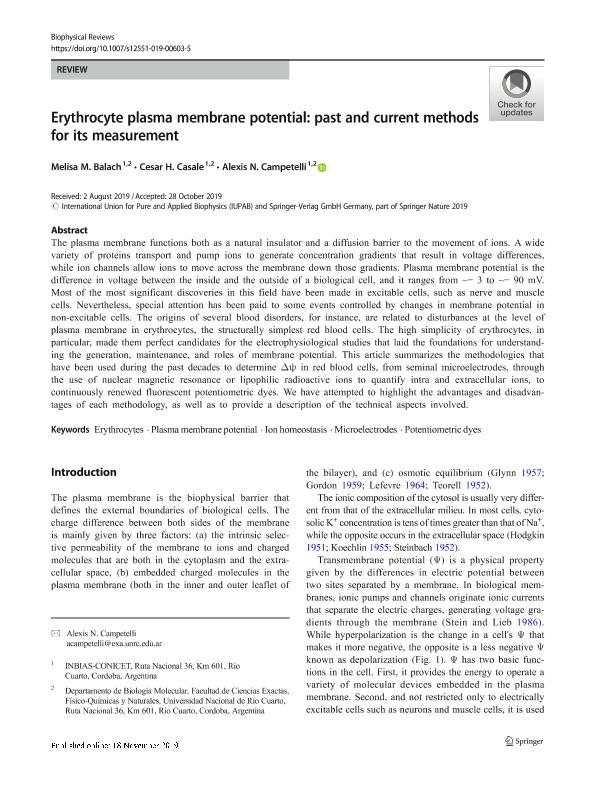Mostrar el registro sencillo del ítem
dc.contributor.author
Balach, Melisa Micaela

dc.contributor.author
Casale, Cesar Horacio

dc.contributor.author
Campetelli, Alexis Nazareno

dc.date.available
2020-12-17T13:07:11Z
dc.date.issued
2019-12
dc.identifier.citation
Balach, Melisa Micaela; Casale, Cesar Horacio; Campetelli, Alexis Nazareno; Erythrocyte plasma membrane potential: Past and current methods for its measurement; Springer; Biophysical Reviews; 11; 6; 12-2019; 995-1005
dc.identifier.issn
1867-2450
dc.identifier.uri
http://hdl.handle.net/11336/120719
dc.description.abstract
The plasma membrane functions both as a natural insulator and a diffusion barrier to the movement of ions. A wide variety of proteins transport and pump ions to generate concentration gradients that result in voltage differences, while ion channels allow ions to move across the membrane down those gradients. Plasma membrane potential is the difference in voltage between the inside and the outside of a biological cell, and it ranges from ~− 3 to ~− 90 mV. Most of the most significant discoveries in this field have been made in excitable cells, such as nerve and muscle cells. Nevertheless, special attention has been paid to some events controlled by changes in membrane potential in non-excitable cells. The origins of several blood disorders, for instance, are related to disturbances at the level of plasma membrane in erythrocytes, the structurally simplest red blood cells. The high simplicity of erythrocytes, in particular, made them perfect candidates for the electrophysiological studies that laid the foundations for understanding the generation, maintenance, and roles of membrane potential. This article summarizes the methodologies that have been used during the past decades to determine Δψ in red blood cells, from seminal microelectrodes, through the use of nuclear magnetic resonance or lipophilic radioactive ions to quantify intra and extracellular ions, to continuously renewed fluorescent potentiometric dyes. We have attempted to highlight the advantages and disadvantages of each methodology, as well as to provide a description of the technical aspects involved.
dc.format
application/pdf
dc.language.iso
eng
dc.publisher
Springer
dc.rights
info:eu-repo/semantics/openAccess
dc.rights.uri
https://creativecommons.org/licenses/by-nc-sa/2.5/ar/
dc.subject
ERYTHROCYTES
dc.subject
ION HOMEOSTASIS
dc.subject
MICROELECTRODES
dc.subject
PLASMA MEMBRANE POTENTIAL
dc.subject
POTENTIOMETRIC DYES
dc.subject.classification
Biofísica

dc.subject.classification
Ciencias Biológicas

dc.subject.classification
CIENCIAS NATURALES Y EXACTAS

dc.title
Erythrocyte plasma membrane potential: Past and current methods for its measurement
dc.type
info:eu-repo/semantics/article
dc.type
info:ar-repo/semantics/artículo
dc.type
info:eu-repo/semantics/publishedVersion
dc.date.updated
2020-11-24T16:43:49Z
dc.identifier.eissn
1867-2469
dc.journal.volume
11
dc.journal.number
6
dc.journal.pagination
995-1005
dc.journal.pais
Alemania

dc.journal.ciudad
Berlin
dc.description.fil
Fil: Balach, Melisa Micaela. Universidad Nacional de Rio Cuarto. Facultad de Cs.exactas Fisicoquimicas y Naturales. Instituto de Biotecnologia Ambiental y Salud. - Consejo Nacional de Investigaciones Cientificas y Tecnicas. Centro Cientifico Tecnologico Conicet - Cordoba. Instituto de Biotecnologia Ambiental y Salud.; Argentina
dc.description.fil
Fil: Casale, Cesar Horacio. Universidad Nacional de Rio Cuarto. Facultad de Cs.exactas Fisicoquimicas y Naturales. Instituto de Biotecnologia Ambiental y Salud. - Consejo Nacional de Investigaciones Cientificas y Tecnicas. Centro Cientifico Tecnologico Conicet - Cordoba. Instituto de Biotecnologia Ambiental y Salud.; Argentina
dc.description.fil
Fil: Campetelli, Alexis Nazareno. Universidad Nacional de Rio Cuarto. Facultad de Cs.exactas Fisicoquimicas y Naturales. Instituto de Biotecnologia Ambiental y Salud. - Consejo Nacional de Investigaciones Cientificas y Tecnicas. Centro Cientifico Tecnologico Conicet - Cordoba. Instituto de Biotecnologia Ambiental y Salud.; Argentina
dc.journal.title
Biophysical Reviews
dc.relation.alternativeid
info:eu-repo/semantics/altIdentifier/doi/http://dx.doi.org/10.1007/s12551-019-00603-5
dc.relation.alternativeid
info:eu-repo/semantics/altIdentifier/url/https://link.springer.com/article/10.1007/s12551-019-00603-5
Archivos asociados
